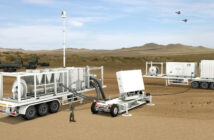
Photo courtesy Architect of the Capitol.
By John Knowles
The DOD released its Fiscal Year 2024 (FY24) budget request in March. The $842 billion descriptions and details about hundreds of the Department’s electronic warfare (EW), signals intelligence (SIGINT) and offensive cyber operations programs and projects. While this is more than we can write about in our news section, we cover some of the highlights below.
DARPA FUNDING NEW MICRO-ELECTRONICS PROGRAMS IN FY24
The Defense Advanced Research Projects Agency’s (DARPA) FY24 budget request shows it is planning to continue its wide investment micro-electronics programs. These include:
- ROPES: The Robust Protection for Electronic Systems (ROPES) seeks to “develop and mature ultra-wide bandgap (UWBG) materials and devices to achieve robust, high-power operation and fast switching speed required to protect sensitive RF electronics in harsh environments.” The program will address “the key technical challenges that limit the performance of conventional diodes and switches. These challenges include: 1) demonstrating materials and device architectures capable of simultaneous high current operation and low leakage current under high electric field and 2) simultaneously achieving low device resistance and capacitance resulting in fast switching speed.” The program will “leverage advances in [ultrawide-bandgap] materials and innovative device architectures to enable high power, high speed, and low loss switches. ROPES will support multiple DOD platforms and arrays by enabling high-power (kilowatt class), low-loss front end receiver protect circuitry, as well as high voltage (10 kilovolt class), low-loss switches required for future electric ship power systems.” This project will begin in FY24 with a $5 million budget.
- VAMPS: Vacuum Electronic Amplifiers for Millimeter-wave Power and Spectrum Superiority (VAMPS) will develop “compact, high-power radio-frequency (RF) signal amplifiers to enable electronic warfare systems to provide DOD platforms with protection from current and evolving millimeter-wave missile seeker threats.” DARPA hopes to exploit the growth of commercial technologies in the millimeter-wave region that is providing “inexpensive RF sources and components, expanding the threat space to increasingly higher frequencies.” Accordingly, “the VAMPS program will develop and demonstrate millimeter-wave vacuum electronic amplifiers integrated with solid-state pre-drivers to achieve breakthrough power and bandwidth to enable DOD electronic attack systems to operate in the high-frequency millimeter-wave portion of the electromagnetic spectrum with increased range and effectiveness.” DARPA is requesting $4 million to start the VAMPS effort in FY24.
- Archie: Under the Archie program, DARPA “seeks to develop techniques to characterize the electromagnetic spectrum to enhance radio frequency (RF) situational awareness, maneuverability, and countermeasures in Anti-Access/Area Denial (A2/AD) environments.” The program will leverage distributed communications technologies developed under DARPA’s earlier Resilient Networked Distributed Mosaic Communications (RN DMC) program “to enhance distributed electromagnetic warfare (EW) capabilities making them more robust and effective. Current radar and EW systems face the challenge of operating in a more congested and contested RF environment. At present, traditional EW systems do not have the capability to characterize this environment, leading to performance degradation. Archie will overcome this by characterizing the electromagnetic spectrum and determining the optimal means by which to deploy radar and EW capabilities.” DARPA is seeking $12.5 million in FY24 to “identify and develop the RF architecture for massive RF characterization” and “initiate technique development and testing.”
- PAIR: DARPA’s Predictive Antijam Artificial Intelligence Receivers (PAIR) program looks to “develop a next-generation artificial intelligence (AI)-enabled antijam receiver, to enable reliable communications links in a fully congested spectrum.” The program will leverage “advances in predictive AI-controlled filters and analog-to-digital converters, as well as neural network digital signal processing producing low latency real-time feedback to the receiver components.” Ultimately, the PAIR program will “enable new capabilities in tactical and long-range radio frequency (RF) communication systems, addressing future military needs for assured, on-demand, antijam information delivery, in environments where today communication would be impossible.” In FY24, the program will begin with a system-level study of AI-based receiver requirements, followed by development of “individual AI-enabled receiver components, including analog filters, analog-to-digital converters, and neural network digital signal processors meeting the derived system study requirements.” The FY24 funding request is $6.5 million.
US NAVY FY24 BUDGET REQUEST FUNDS SCALED SHIPBORNE EA, NGJ UPGRADES
The US Navy is pursuing two new initiatives in FY24. It wants to begin developing a scaled shipborne electronic attack (EA) system for integration in warships too small to receive the AN/SLQ-32(V)7 suite. And for its Airborne Electronic Attack (AEA) mission, the Navy has formalized its plan to extend the frequency range of its ALQ-249 Next Generation Jammer Mid-Band (NGJ-MB) pod.
- SOEA: A $38.2 million funding line (within PE 0604757N / Ship Self Def (Engage: Soft Kill/EW), 0954 / Shipboard EW Improvement Program) has been included in the Navy’s FY24 budget request to establish the Scaled Onboard Electronic Attack (SOEA) program and commence development under a Middle Tier Rapid Prototyping acquisition strategy. SOEA will assimilate into the wider SEWIP family of shipboard EW systems, and integrate with the AN/SLQ-32(V)6 electronic support (ES) system delivered by Lockheed Martin under SEWIP Block 2. SOEA is being developed to provide an onboard EA capability for smaller ships, such as the new FFG-62 Constellation-class frigates, which cannot accommodate a SEWIP Block 3 EA fit. The SOEA program will also include a government software development and integration effort for a Soft-Kill Coordinator System (SKCS). The SKCS, already being implemented for AN/SLQ-32(V)6 and AN/SLQ-32(V)7 systems, provides direction and scheduling for both onboard and offboard EA and soft-kill decoys.
Phase 1 preliminary prototypes – awards to up to three vendors are planned – are due for delivery in early FY2026. A subsequent integrated system development activity – Phase 2 – will utilize a competitive OTA contract to build on critical technologies, engineer design modularity, establish critical external interfaces for system and platform integration, and complete software development. Plans call for the Engineering Development Model delivery to a land-based test site in FY2028. Phase 2 will also rapidly field initial production-representative units.
- NGJ-MBX: The Navy is also requesting $25.4 million in FY24 to begin moving forward with a program to expand the frequency range of its ALQ-249 Next Generation Jammer Mid-Band (NGJ-MB) pod. Known as NGJ Mid-Band Extended (NGJ-MBX) (part of Project 0557 under PE 0604274N / Next Generation Jammer), this effort will “address the upper frequency coverage limit to cover current key threats.” FY24 work will include a “System Requirements Review (SRR) and defining subsystem requirements, assessing risk reduction trades and early design efforts, conducting a system Preliminary Design Review, and beginning aircraft/software integration efforts, developmental test and all support and management services associated with MBX.” Previously, the Navy had anticipated developing a separate high-band NGJ pod – part of a three-pod NGJ solution for low-band, mid-band and high-band coverage. If the NGJ MBX effort proves successful, it could potentially save the Navy hundreds of millions of dollars in NGJ High-Band pod R&D funds and perhaps billions in procurement. – J. Knowles and R. Scott
US ARMY MOVES FORWARD WITH EW/SIGINT MODERNIZATION STRATEGY
The US Army’s budget request includes a few new EMSO-related R&D efforts plus solid funding support for its major EW and SIGINT programs.
- EWPMT: The Army made two requests improve the navigation warfare (NAVWAR) features of its Electronic Warfare Planning and Management Tool (EWPMT) program. The Intelligent Electronic Protect (IEP) Advanced Technology project is an FY24 new start ($6 million) within PE 0603463A / Network C3I Advanced Technology Project (Number/Name) AV8 / NAVWAR Advanced Technology. According to the description, “This effort matures and demonstrates hardware and software capabilities that will enable an Assured Position Navigation and Timing (APNT) system to function as a NAVWAR sensor. The IEP enabled APNT system will be able to detect and identify information about jamming and spoofing threats in the Global Positioning System (GPS) environment,” and allow the EWPMT to “create a NAVWAR Common Operating Picture with greater accuracy and coverage, allowing commanders to make more informed decisions about maneuver and allowing for more accurate and successful fires missions.”
A related effort, the Navigation Warfare Situational Awareness (NAVWAR-SA) project, is an Advanced Component Development & Prototypes (ACD&P) program within PE 0604103A to preserve “the effectiveness of maneuvers and fires missions by enabling the Commander to understand when GPS jammers are present, where they are located, and what areas they are impacting. The Army’s NAVWAR-SA request for $2.2 million would initiate transition and integration of Tactical NAVWAR Plexus software (developed under PE 0604115A / Technology Maturation Initiatives) into the EWPMT software baseline,” develop an API and then test it.
The Army’s main EWPMT program will continue its System Development and Demonstration (SDD) phase with “capability maturation, performance improvements, system hardening, and integration with Terrestrial Layer System (TLS) / Multi-Function Electronic Warfare (MFEW) variants. The Army requested $5 million for these efforts. FY24 marks an important year for the EWPMT program, as the software suite transitions to procurement and fielding, with $21.3 million requested to support these efforts.
- MFEW-AL: After zeroing it’s FY23 R&D budget for the Multi-Function EW Air Large (MFEW-AL) program, the Army has restored development and procurement funding lines in FY24. Under PE 0604270A / Electronic Warfare Development, Project DX6 / Multi-Function Electronic Warfare (MFEW), the Army requested $5.6 million for Gray Eagle integration engineering and testing. It also requested $15.9 million to procure two MFEW-AL systems in FY24, and it plans to seek $23.4 million to buy four more systems in FY25. The Army plans to begin Developmental Testing this year and begin full-rate production in Q2 FY26.
- TLS-BCT: The Army’s Terrestrial Layer System – Brigade Combat Team (TLS-BCT) program received significant funding support in the FY24 budget request. For continued development of the TLS-BCT system, which will provide brigade commanders with SIGINT, EW and cyber-attack capabilities, the Army requested $65 million in FY24 (PE 0304270A / Electronic Warfare Development, FJ5 / Terrestrial Layer System). This is a $53 million increase above what the Army indicated it was budgeting for FY24 when it submitted its FY23-27 request in April 2022. The FY24 funds will be used for “continued development of System Level Prototypes and integration of TLS BCT mission equipment to Stryker, Manpack, AMPV and IBCT mounted variants.” Upcoming milestones include a TLS Manpack demonstration in Q4 FY23; TLS Manpack rapid fielding decision point in Q1 FY24; Stryker variant Operational Demonstration in Q4 FY23; Stryker rapid fielding decision point Q2 FY24; and AMPV variant prototyping from Q2 FY23 to Q3 FY25. Procurement for the TLS-BCT program begins in FY24, with $32.6 million requested for four TLS-BCT Striker vehicles to be produced by Lockheed Martin (Owego, NY) and $39.2 million for 52 Manpack systems to be manufactured by Mastodon Design, a CACI business unit (Rochester, NY).
- TLS-EAB: The Army requested $66.5 million for its TLS-Echelon Above Brigade (TLS-EAB) program (PE 0304270A / Electronic Warfare Development, Project CK3 TLS EAB), which represents $48.3 million increase above what the Army had planned for FY24 in last year’s budget request. The additional funding supports full-scale development and testing of two prototypes to be developed by Lockheed Martin. Upcoming program milestones include First Unit Equipped (FUE) in Q2 FY25 and production and fielding Q2 FY26 – Q4 FY30. – J. Knowles
US AIR FORCE PURSUES SEVERAL “NEW START” EMSO-RELATED EFFORTS IN FY24
The US Air Force’s FY24 budget request includes funding for major EW programs, such as Compass Call and the F-15 Eagle Passive/Active Warning and Survivability System (EPAWSS), as well as some EMSO-related “new starts.”
- Compass Call: The Air Force ‘s FY24 Compass Call R&D budget line (PE 0207253F / Compass Call) requests $66.9 million to focus on Baseline 4 integration and testing on the EC-37B. Baseline 4 “transitions the software baseline to an agile software framework and implements System-Wide Open Reconfigurable Dynamic Architecture (SWORD-A) to enable rapid integration of new capabilities offering increased target capacity.” FY24 funding also addresses “maturation of AEA technologies,” and development the program’s Baseline 5 requirements. The FY24 request represents an increase over FY23 spending ($50 million) and is part of a series of planned budget increases over the next couple of years: $82.2 million in FY25 and $131.9 in FY26. The Compass Call procurement line shrinks from $327.3 million in FY23 to $144.7 in FY24, reflecting that all 10 EC-37B airframes have been procured (the last four funded by a congressional add in FY23). The first 5 EC-37Bs will initially receive the Baseline 3 configuration (3 deliveries in FY23 and 2 more in FY24). The last five aircraft will be delivered in the Baseline 4 configuration beginning in FY27.
- EPAWSS: The F-15E EPAWSS program continues growing its procurement numbers with a $280 million FY24 request that includes $72.5 million for 21 B-kits. Procurement funding is expected to increase to $321.3 million in FY25 and will include $18.3 million for another 35 systems, completing the Air Force’s plan to buy 99 systems.
• New Starts: In its R&D lines, the Air Force is beginning several new programs. Among these, in its main EW development line (PE 0604270F / Electronic Warfare Development), it requests $5 million for a new “Cognitive Electromagnetic Warfare (EW)” project which seeks to perform a capabilities based assessment (CBA) for an “Air Force capability to analyze adversaries’ use of the electromagnetic spectrum, make real-time decisions assisted by machine learning/artificial intelligence, perform effective electromagnetic attack (EA) and share EA techniques and identification/targeting criteria to the warfighting force.” PE 0604270F also includes $5 million for an Electromagnetic Battle Management (EMBM) project that will “perform assessments and analyses for an Air Force capability to provide electromagnetic spectrum situational awareness, decision support, and command and control – linked by common architectures, standards, and data – to enable planning, coordination, and synchronization of electromagnetic spectrum operations (EMSO) across the range of military operations.”






